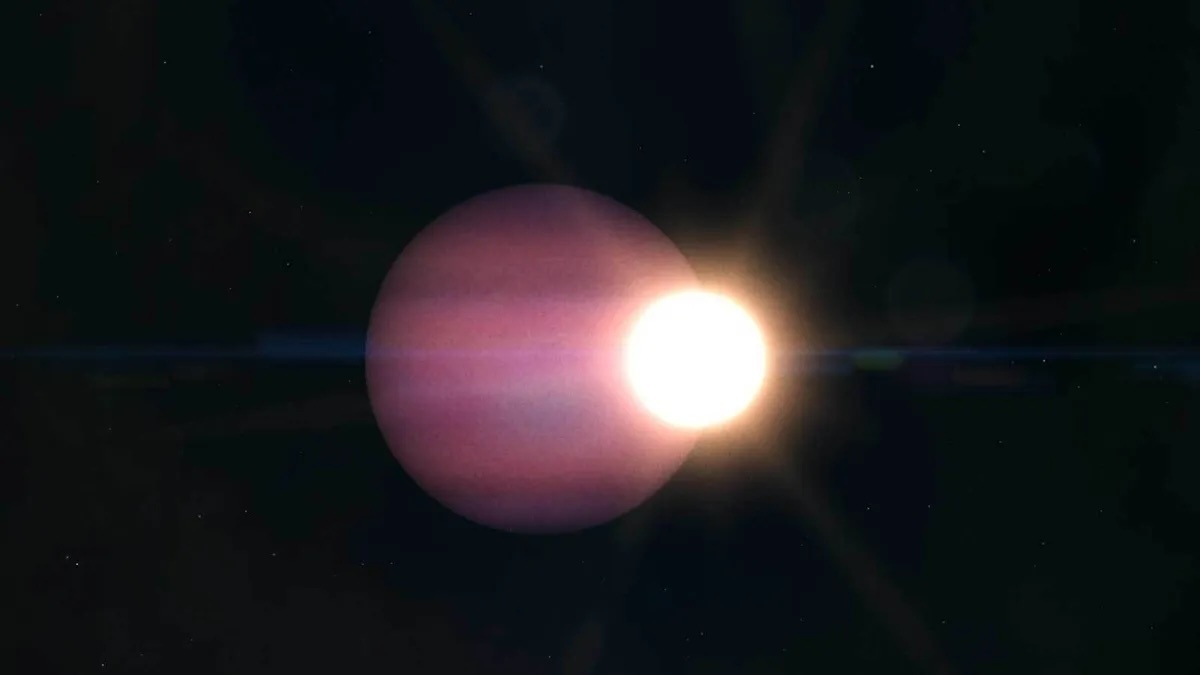26.03.2025
NASA’s Webb Telescope Unmasks True Nature of the Cosmic Tornado
Craving an ice cream sundae with a cherry on top? This random alignment of Herbig-Haro 49/50 — a frothy-looking outflow from a nearby protostar — with a multi-hued spiral galaxy may do the trick. This new composite image combining observations from NASA’s James Webb Space Telescope’s NIRCam (Near-Infrared Camera) and MIRI (Mid-Infrared Instrument) provides a high-resolution view to explore the exquisite details of this bubbling activity.
Herbig-Haro objects are outflows produced by jets launched from a nearby, forming star. The outflows, which can extend for light-years, plow into a denser region of material. This creates shock waves, heating the material to higher temperatures. The material then cools by emitting light at visible and infrared wavelengths.
Image A:
Herbig-Haro 49/50 (NIRCam and MIRI Image)
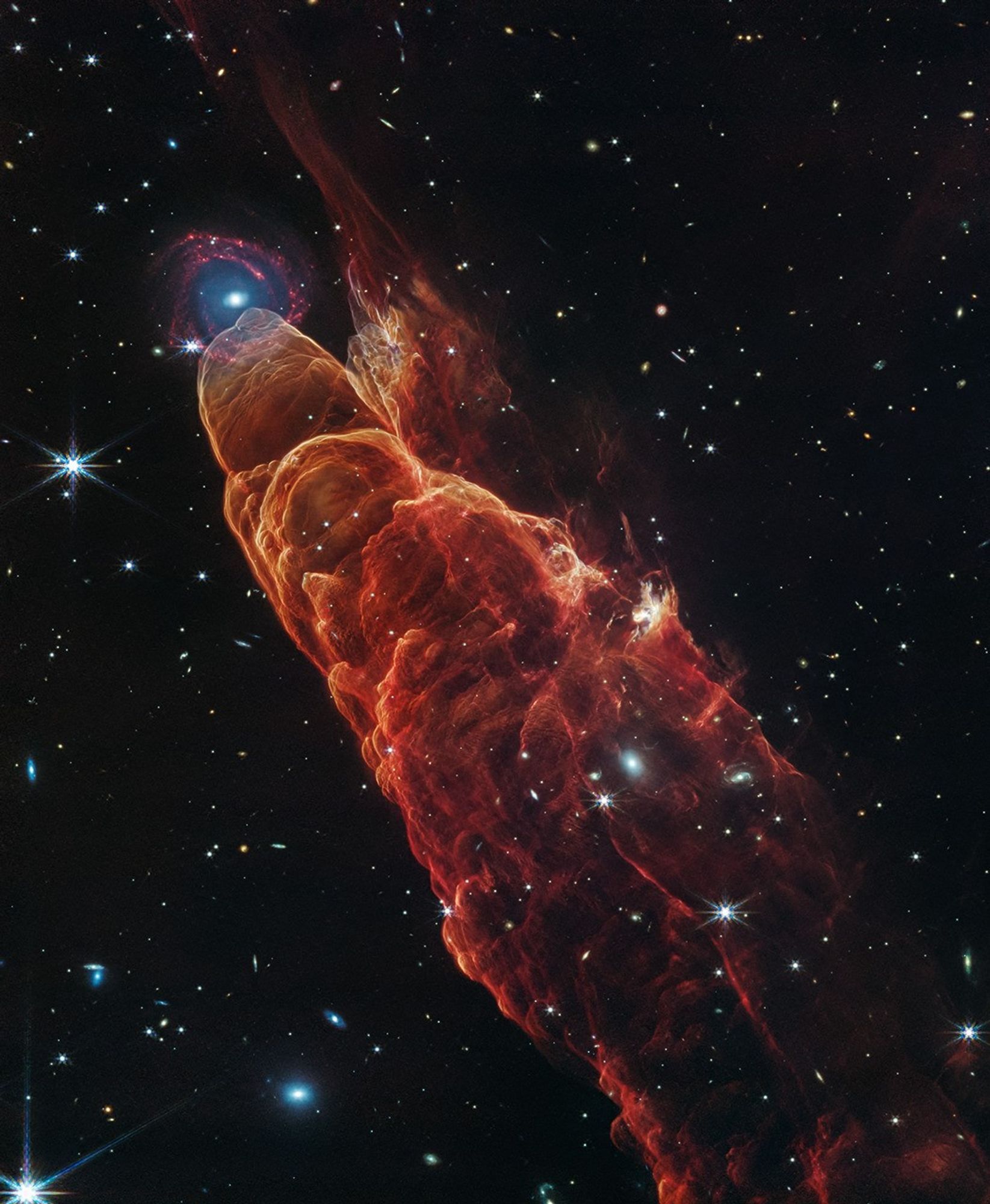
When NASA’s retired Spitzer Space Telescope observed it in 2006, scientists nicknamed Herbig-Haro 49/50 (HH 49/50) the “Cosmic Tornado” for its helical appearance, but they were uncertain about the nature of the fuzzy object at the tip of the “tornado.” With its higher imaging resolution, Webb provides a different visual impression of HH 49/50 by revealing fine features of the shocked regions in the outflow, uncovering the fuzzy object to be a distant spiral galaxy, and displaying a sea of distant background galaxies.
Image B:
Herbig-Haro 49/50 (Spitzer and Webb Images Side-by-Side)
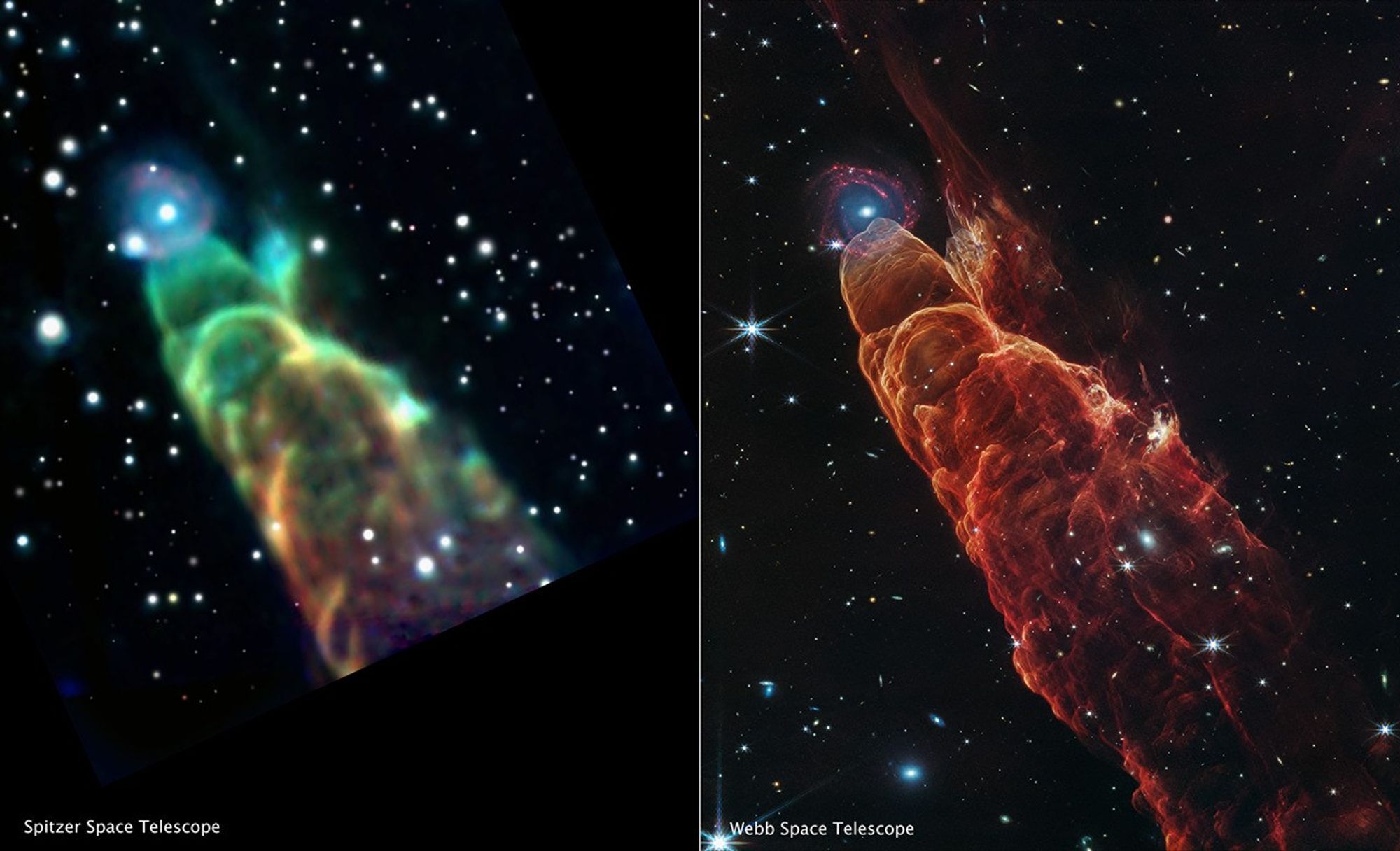
HH 49/50 is located in the Chamaeleon I Cloud complex , one of the nearest active star formation regions in our Milky Way, which is creating numerous low-mass stars similar to our Sun. This cloud complex is likely similar to the environment that our Sun formed in. Past observations of this region show that the HH 49/50 outflow is moving away from us at speeds of 60-190 miles per second (100-300 kilometers per second) and is just one feature of a larger outflow.
Webb’s NIRCam and MIRI observations of HH 49/50 trace the location of glowing hydrogen molecules, carbon monoxide molecules, and energized grains of dust, represented in orange and red, as the protostellar jet slams into the region. Webb’s observations probe details on small spatial scales that will help astronomers to model the properties of the jet and understand how it is affecting the surrounding material.
The arc-shaped features in HH 49/50, similar to a water wake created by a speeding boat, point back to the source of this outflow. Based on past observations, scientists suspect that a protostar known as Cederblad 110 IRS4 is a plausible driver of the jet activity. Located roughly 1.5 light-years away from HH 49/50 (off the lower right corner of the Webb image), CED 110 IRS4 is a Class I protostar. Class I protostars are young objects (tens of thousands to a million years old) in the prime time of gaining mass. They usually have a discernable disk of material surrounding them that is still falling onto the protostar. Scientists recently used Webb’s NIRCam and MIRI observations to study this protostar and obtain an inventory of the icy composition of its environment.
These detailed Webb images of the arcs in HH 49/50 can more precisely pinpoint the direction to the jet source, but not every arc points back in the same direction. For example, there is an unusual outcrop feature (at the top right of the main outflow) which could be another chance superposition of a different outflow, related to the slow precession of the intermittent jet source. Alternatively, this feature could be a result of the main outflow breaking apart.
This visualization examines the three-dimensional structure of Herbig-Haro 49/50 (HH 49/50) as seen in near- and mid-infrared light by the James Webb Space Telescope. HH 49/50 is an outflow produced by the jet of a nearby still-forming star in the Chamaeleon I Cloud complex, one of the nearest active star formation regions in our Milky Way. At a distance of 625 light-years from Earth, this new composite infrared image (using data from program 6558, PI: M. Garcia Marin) allows researchers to examine its details on small spatial scales like never before.
Visualization Credit: NASA, ESA, CSA, J. DePasquale (STScI), L. Hustak (STScI), G. Bacon (STScI), R. Crawford (STScI), D. Kirshenblat (STScI), C. Nieves (STScI), A. Pagan (STScI), F. Summers (STScI).
The galaxy that appears by happenstance at the tip of HH 49/50 is a much more distant, face-on spiral galaxy. It has a prominent central bulge represented in blue that shows the location of older stars. The bulge also shows hints of “side lobes” suggesting that this could be a barred-spiral galaxy. Reddish clumps within the spiral arms show the locations of warm dust and groups of forming stars. The galaxy even displays evacuated bubbles in these dusty regions, similar to nearby galaxies observed by Webb as part of the PHANGS program.
Webb has captured these two unassociated objects in a lucky alignment. Over thousands of years, the edge of HH 49/50 will move outwards and eventually appear to cover up the distant galaxy.
Want more? Take a closer look at the image, “fly through” it in a visualization, and compare Webb’s image to the Spitzer Space Telescope’s.
Herbig-Haro 49/50 is located about 625 light-years from Earth in the constellation Chamaeleon.
The James Webb Space Telescope is the world’s premier space science observatory. Webb will solve mysteries in our solar system, look beyond to distant worlds around other stars, and probe the mysterious structures and origins of our universe and our place in it. Webb is an international program led by NASA with its partners, ESA (European Space Agency) and the Canadian Space Agency.
Quelle: NASA
----
Update: 28.03.2025
.
NASA’s Webb Sees Galaxy Mysteriously Clearing Fog of Early Universe
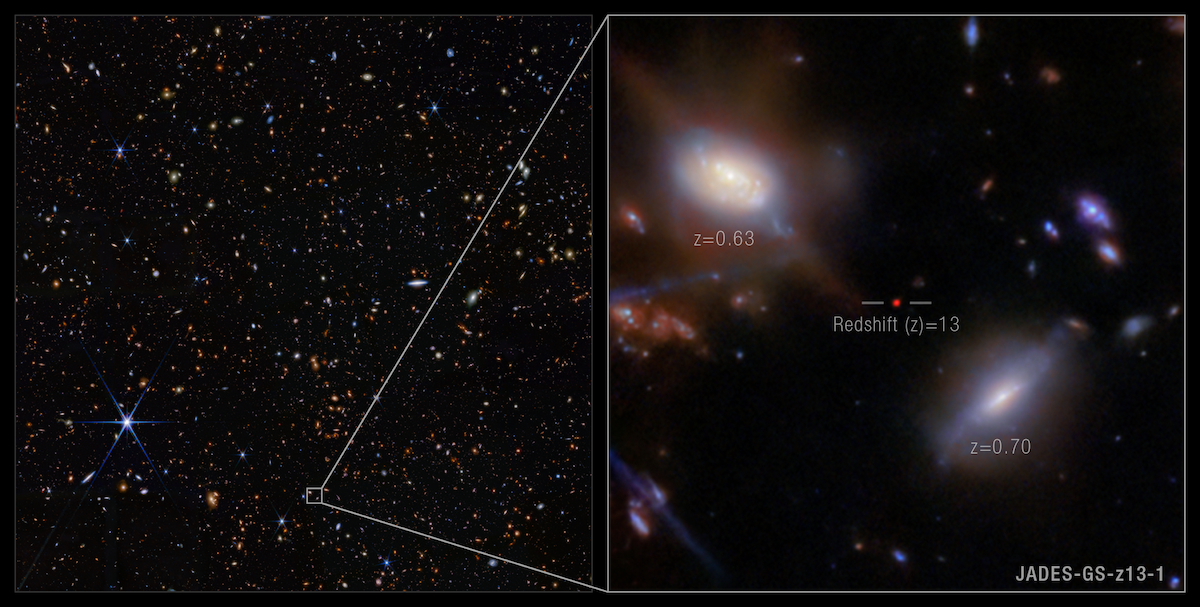
Using the unique infrared sensitivity of NASA’s James Webb Space Telescope, researchers can examine ancient galaxies to probe secrets of the early universe. Now, an international team of astronomers has identified bright hydrogen emission from a galaxy in an unexpectedly early time in the universe’s history. The surprise finding is challenging researchers to explain how this light could have pierced the thick fog of neutral hydrogen that filled space at that time.
The Webb telescope discovered the incredibly distant galaxy JADES-GS-z13-1, observed to exist just 330 million years after the big bang, in images taken by Webb’s NIRCam (Near-Infrared Camera) as part of the James Webb Space Telescope Advanced Deep Extragalactic Survey (JADES). Researchers used the galaxy’s brightness in different infrared filters to estimate its redshift, which measures a galaxy’s distance from Earth based on how its light has been stretched out during its journey through expanding space.
Image A: JADES-GS-z13-1 in the GOODS-S field (NIRCam Image)
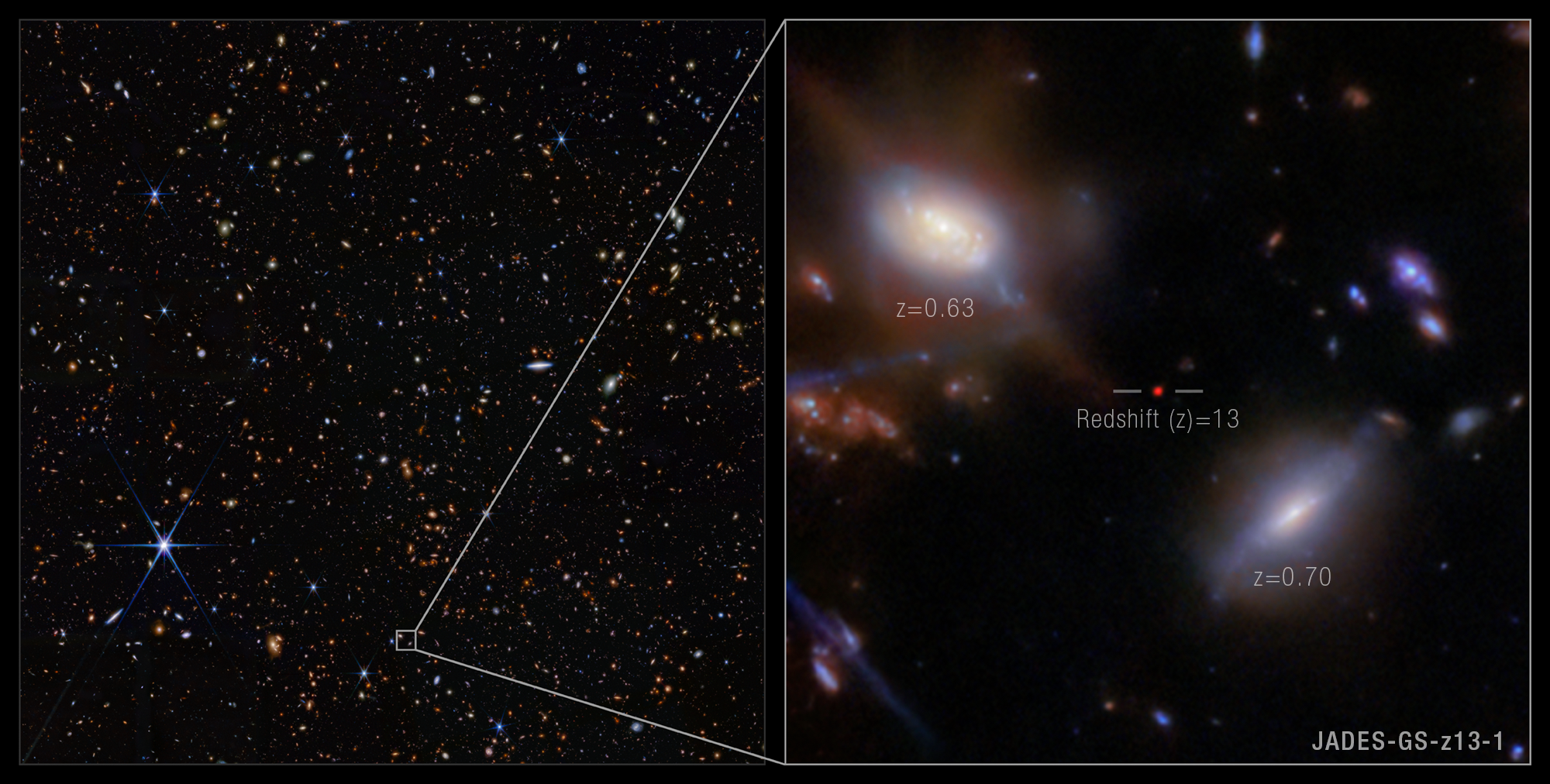
Image B: JADES-GS-z13-1 (NIRCam Close-Up)
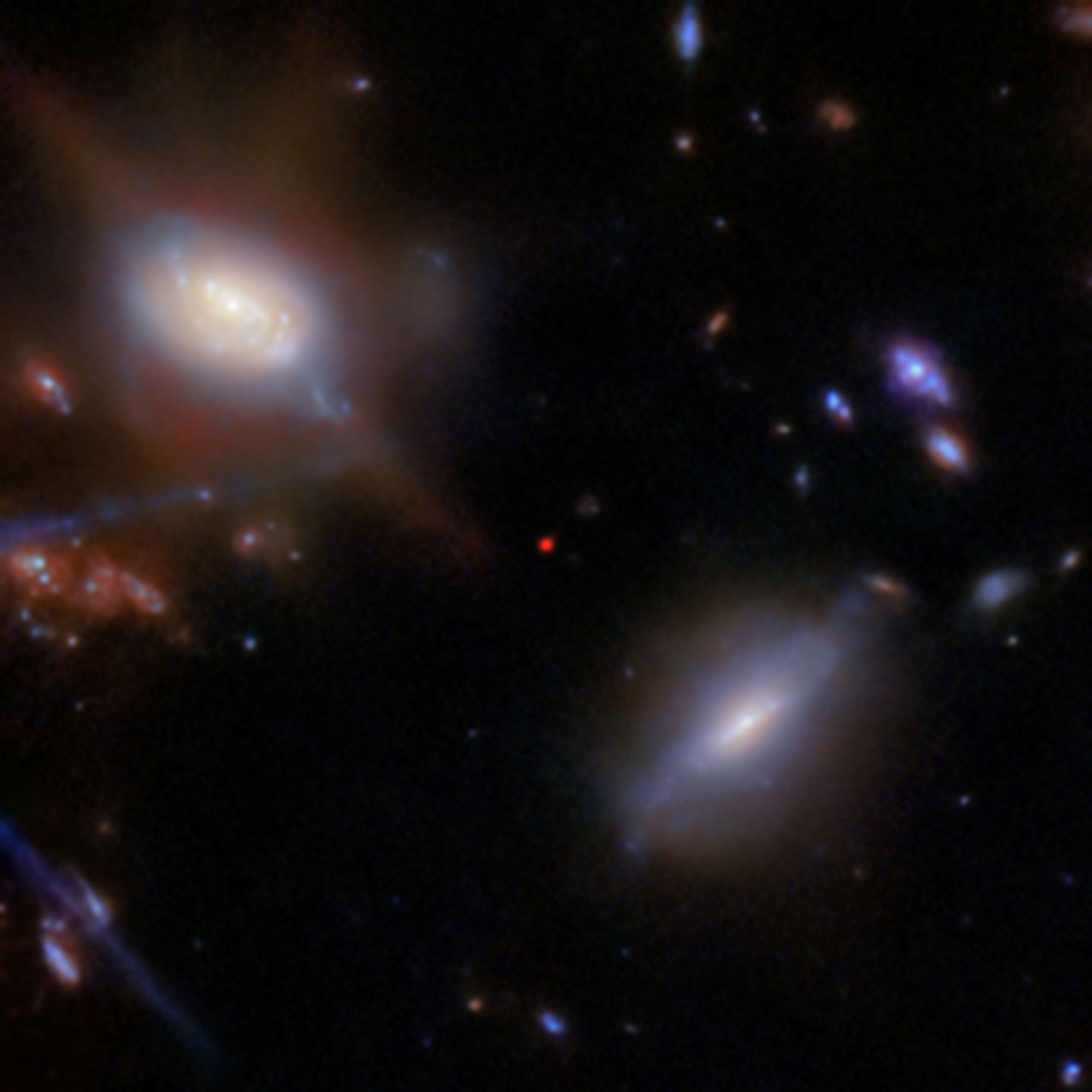
The NIRCam imaging yielded an initial redshift estimate of 12.9. Seeking to confirm its extreme redshift, an international team lead by Joris Witstok of the University of Cambridge in the United Kingdom, as well as the Cosmic Dawn Center and the University of Copenhagen in Denmark, then observed the galaxy using Webb’s Near-Infrared Spectrograph instrument.
In the resulting spectrum, the redshift was confirmed to be 13.0. This equates to a galaxy seen just 330 million years after the big bang, a small fraction of the universe’s present age of 13.8 billion years old. But an unexpected feature stood out as well: one specific, distinctly bright wavelength of light, known as Lyman-alpha emission, radiated by hydrogen atoms. This emission was far stronger than astronomers thought possible at this early stage in the universe’s development.
“The early universe was bathed in a thick fog of neutral hydrogen,” explained Roberto Maiolino, a team member from the University of Cambridge and University College London. “Most of this haze was lifted in a process called reionization, which was completed about one billion years after the big bang. GS-z13-1 is seen when the universe was only 330 million years old, yet it shows a surprisingly clear, telltale signature of Lyman-alpha emission that can only be seen once the surrounding fog has fully lifted. This result was totally unexpected by theories of early galaxy formation and has caught astronomers by surprise.”
Image C: JADES-GS-z13-1 Spectrum Graphic
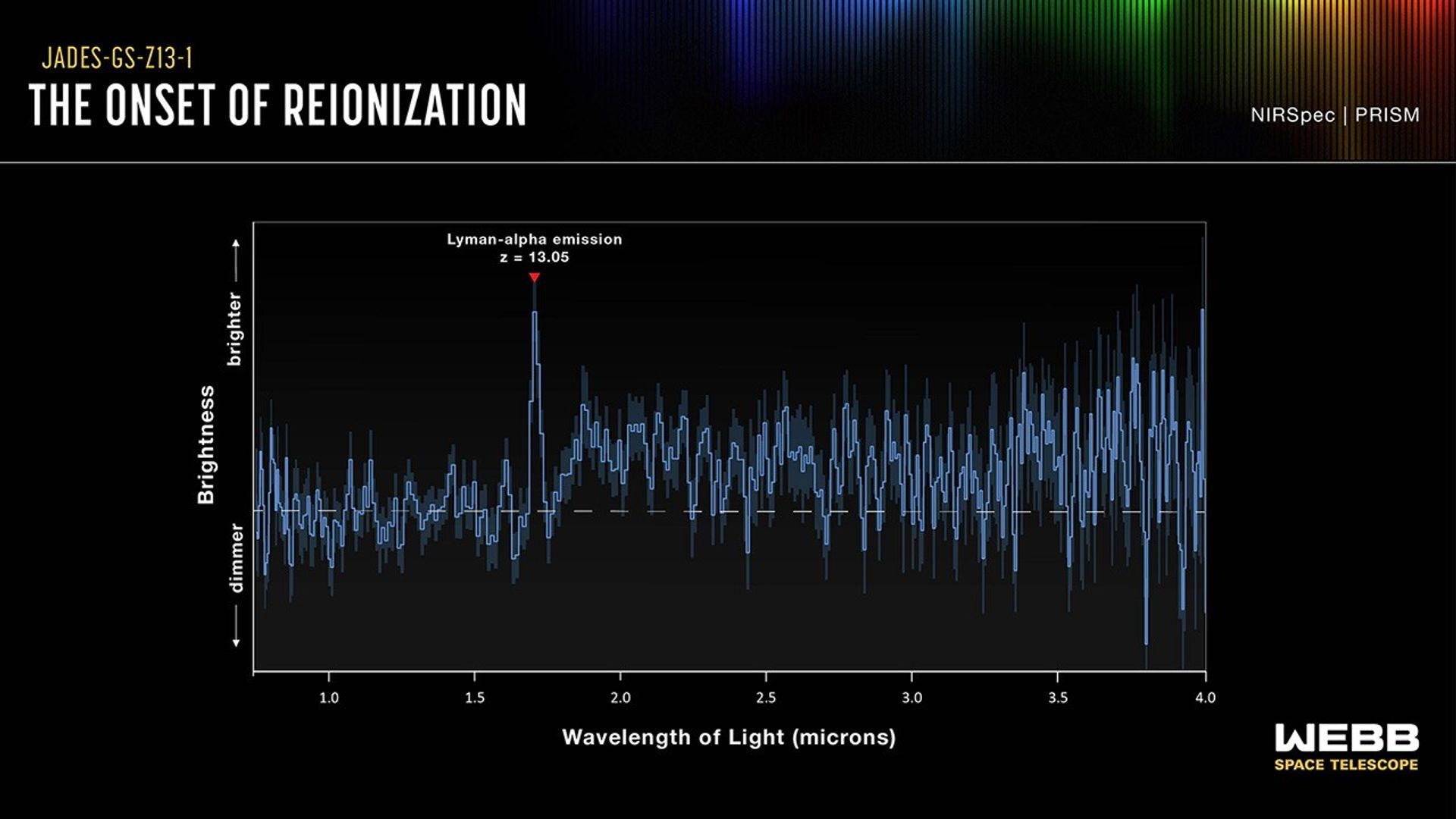
Before and during the era of reionization, the immense amounts of neutral hydrogen fog surrounding galaxies blocked any energetic ultraviolet light they emitted, much like the filtering effect of colored glass. Until enough stars had formed and were able to ionize the hydrogen gas, no such light — including Lyman-alpha emission — could escape from these fledgling galaxies to reach Earth. The confirmation of Lyman-alpha radiation from this galaxy, therefore, has great implications for our understanding of the early universe.
“We really shouldn’t have found a galaxy like this, given our understanding of the way the universe has evolved,” said Kevin Hainline, a team member from the University of Arizona. “We could think of the early universe as shrouded with a thick fog that would make it exceedingly difficult to find even powerful lighthouses peeking through, yet here we see the beam of light from this galaxy piercing the veil. This fascinating emission line has huge ramifications for how and when the universe reionized.”
The source of the Lyman-alpha radiation from this galaxy is not yet known, but it may include the first light from the earliest generation of stars to form in the universe.
“The large bubble of ionized hydrogen surrounding this galaxy might have been created by a peculiar population of stars — much more massive, hotter, and more luminous than stars formed at later epochs, and possibly representative of the first generation of stars,” said Witstok. A powerful active galactic nucleus, driven by one of the first supermassive black holes, is another possibility identified by the team.
This research was published Wednesday in the journal Nature.
The James Webb Space Telescope is the world's premier space science observatory. Webb is solving mysteries in our solar system, looking beyond to distant worlds around other stars, and probing the mysterious structures and origins of our universe and our place in it. Webb is an international program led by NASA with its partners, ESA (European Space Agency) and CSA (Canadian Space Agency).
Quelle: NASA
+++
NASA’s Webb Captures Neptune’s Auroras For First Time
Long-sought auroral glow finally emerges under Webb’s powerful gaze
For the first time, NASA’s James Webb Space Telescope has captured bright auroral activity on Neptune. Auroras occur when energetic particles, often originating from the Sun, become trapped in a planet’s magnetic field and eventually strike the upper atmosphere. The energy released during these collisions creates the signature glow.
In the past, astronomers have seen tantalizing hints of auroral activity on Neptune, for example, in the flyby of NASA’s Voyager 2 in 1989. However, imaging and confirming the auroras on Neptune has long evaded astronomers despite successful detections on Jupiter, Saturn, and Uranus. Neptune was the missing piece of the puzzle when it came to detecting auroras on the giant planets of our solar system.
“Turns out, actually imaging the auroral activity on Neptune was only possible with Webb’s near-infrared sensitivity,” said lead author Henrik Melin of Northumbria University, who conducted the research while at the University of Leicester. “It was so stunning to not just see the auroras, but the detail and clarity of the signature really shocked me.”
The data was obtained in June 2023 using Webb’s Near-Infrared Spectrograph. In addition to the image of the planet, astronomers obtained a spectrum to characterize the composition and measure the temperature of the planet’s upper atmosphere (the ionosphere). For the first time, they found an extremely prominent emission line signifying the presence of the trihydrogen cation (H3+), which can be created in auroras. In the Webb images of Neptune, the glowing aurora appears as splotches represented in cyan.
Image A:
Neptune's Auroras - Hubble and Webb
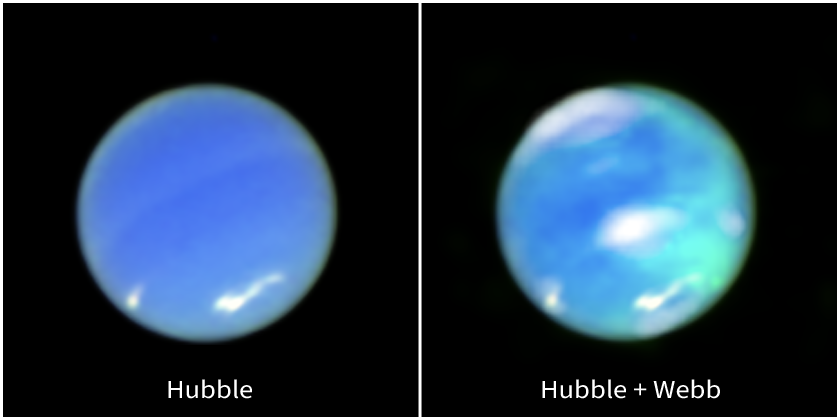
“H3+ has a been a clear signifier on all the gas giants — Jupiter, Saturn, and Uranus — of auroral activity, and we expected to see the same on Neptune as we investigated the planet over the years with the best ground-based facilities available,” explained Heidi Hammel of the Association of Universities for Research in Astronomy, Webb interdisciplinary scientist and leader of the Guaranteed Time Observation program for the Solar System in which the data were obtained. “Only with a machine like Webb have we finally gotten that confirmation.”
The auroral activity seen on Neptune is also noticeably different from what we are accustomed to seeing here on Earth, or even Jupiter or Saturn. Instead of being confined to the planet’s northern and southern poles, Neptune’s auroras are located at the planet’s geographic mid-latitudes — think where South America is located on Earth.
This is due to the strange nature of Neptune’s magnetic field, originally discovered by Voyager 2 in 1989 which is tilted by 47 degrees from the planet’s rotation axis. Since auroral activity is based where the magnetic fields converge into the planet’s atmosphere, Neptune’s auroras are far from its rotational poles.
The ground-breaking detection of Neptune’s auroras will help us understand how Neptune’s magnetic field interacts with particles that stream out from the Sun to the distant reaches of our solar system, a totally new window in ice giant atmospheric science.
From the Webb observations, the team also measured the temperature of the top of Neptune’s atmosphere for the first time since Voyager 2’s flyby. The results hint at why Neptune’s auroras remained hidden from astronomers for so long.
“I was astonished — Neptune’s upper atmosphere has cooled by several hundreds of degrees,” Melin said. “In fact, the temperature in 2023 was just over half of that in 1989.”
Through the years, astronomers have predicted the intensity of Neptune’s auroras based on the temperature recorded by Voyager 2. A substantially colder temperature would result in much fainter auroras. This cold temperature is likely the reason that Neptune’s auroras have remained undetected for so long. The dramatic cooling also suggests that this region of the atmosphere can change greatly even though the planet sits over 30 times farther from the Sun compared to Earth.
Equipped with these new findings, astronomers now hope to study Neptune with Webb over a full solar cycle, an 11-year period of activity driven by the Sun’s magnetic field. Results could provide insights into the origin of Neptune’s bizarre magnetic field, and even explain why it’s so tilted.
“As we look ahead and dream of future missions to Uranus and Neptune, we now know how important it will be to have instruments tuned to the wavelengths of infrared light to continue to study the auroras,” added Leigh Fletcher of Leicester University, co-author on the paper. “This observatory has finally opened the window onto this last, previously hidden ionosphere of the giant planets.”
These observations, led by Fletcher, were taken as part of Hammel’s Guaranteed Time Observation program 1249. The team’s results have been published in Nature Astronomy.
The James Webb Space Telescope is the world's premier space science observatory. Webb is solving mysteries in our solar system, looking beyond to distant worlds around other stars, and probing the mysterious structures and origins of our universe and our place in it. Webb is an international program led by NASA with its partners, ESA (European Space Agency) and CSA (Canadian Space Agency)
Quelle: NASA
----
Update: 12.04.2025
.
NASA Webb’s Autopsy of Planet Swallowed by Star Yields Surprise
Observations from NASA’s James Webb Space Telescope have provided a surprising twist in the narrative surrounding what is believed to be the first star observed in the act of swallowing a planet. The new findings suggest that the star actually did not swell to envelop a planet as previously hypothesized. Instead, Webb’s observations show the planet’s orbit shrank over time, slowly bringing the planet closer to its demise until it was engulfed in full.
“Because this is such a novel event, we didn’t quite know what to expect when we decided to point this telescope in its direction,” said Ryan Lau, lead author of the new paper and astronomer at NSF NOIRLab (National Science Foundation National Optical-Infrared Astronomy Research Laboratory) in Tucson, Arizona. “With its high-resolution look in the infrared, we are learning valuable insights about the final fates of planetary systems, possibly including our own.”
Two instruments aboard Webb conducted the post-mortem of the scene – Webb’s MIRI (Mid-Infrared Instrument) and NIRSpec (Near-Infrared Spectrograph). The researchers were able to come to their conclusion using a two-pronged investigative approach.
Image A: Planetary Engulfment Illustration
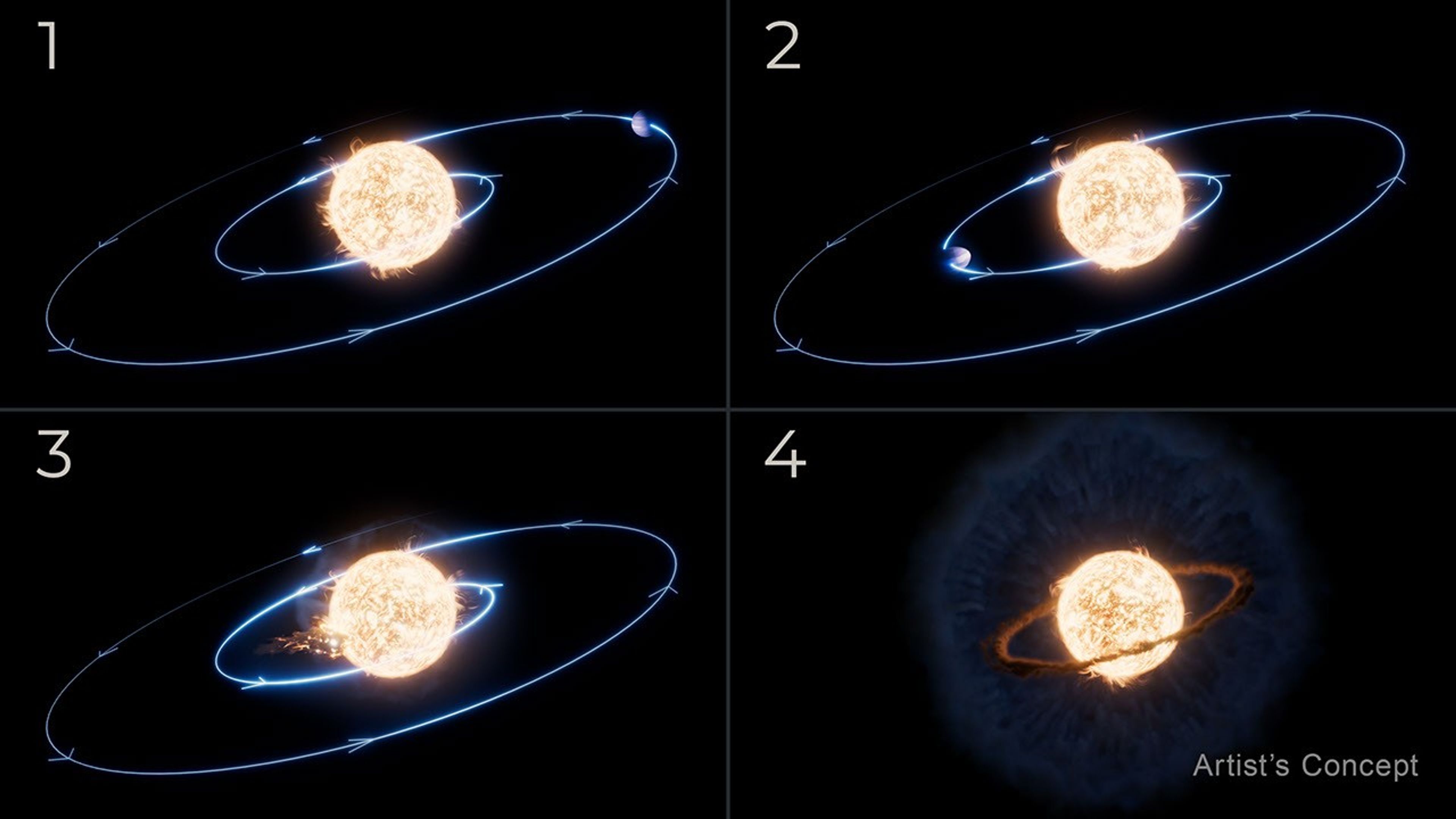
Constraining the How
The star at the center of this scene is located in the Milky Way galaxy about 12,000 light-years away from Earth.
The brightening event, formally called ZTF SLRN-2020, was originally spotted as a flash of optical light using the Zwicky Transient Facility at Caltech's Palomar Observatory in San Diego, California. Data from NASA’s NEOWISE (Near-Earth Object Wide-field Infrared Survey Explorer) showed the star actually brightened in the infrared a year before the optical light flash, hinting at the presence of dust. This initial 2023 investigation led researchers to believe that the star was more Sun-like, and had been in the process of aging into a red giant over hundreds of thousands of years, slowly expanding as it exhausted its hydrogen fuel.
However, Webb’s MIRI told a different story. With powerful sensitivity and spatial resolution, Webb was able to precisely measure the hidden emission from the star and its immediate surroundings, which lie in a very crowded region of space. The researchers found the star was not as bright as it should have been if it had evolved into a red giant, indicating there was no swelling to engulf the planet as once thought.
Reconstructing the Scene
Researchers suggest that, at one point, the planet was about Jupiter-sized, but orbited quite close to the star, even closer than Mercury’s orbit around our Sun. Over millions of years, the planet orbited closer and closer to the star, leading to the catastrophic consequence.
“The planet eventually started to graze the star's atmosphere. Then it was a runaway process of falling in faster from that moment,” said team member Morgan MacLeod of the Harvard-Smithsonian Center for Astrophysics and the Massachusetts Institute of Technology in Cambridge, Massachusetts. “The planet, as it’s falling in, started to sort of smear around the star.”
In its final splashdown, the planet would have blasted gas away from the outer layers of the star. As it expanded and cooled off, the heavy elements in this gas condensed into cold dust over the next year.
Inspecting the Leftovers
While the researchers did expect an expanding cloud of cooler dust around the star, a look with the powerful NIRSpec revealed a hot circumstellar disk of molecular gas closer in. Furthermore, Webb’s high spectral resolution was able to detect certain molecules in this accretion disk, including carbon monoxide.
“With such a transformative telescope like Webb, it was hard for me to have any expectations of what we’d find in the immediate surroundings of the star,” said Colette Salyk of Vassar College in Poughkeepsie, New York, an exoplanet researcher and co-author on the new paper. “I will say, I could not have expected seeing what has the characteristics of a planet-forming region, even though planets are not forming here, in the aftermath of an engulfment.”
The ability to characterize this gas opens more questions for researchers about what actually happened once the planet was fully swallowed by the star.
“This is truly the precipice of studying these events. This is the only one we've observed in action, and this is the best detection of the aftermath after things have settled back down,” Lau said. “We hope this is just the start of our sample.”
These observations, taken under Guaranteed Time Observation program 1240, which was specifically designed to investigate a family of mysterious, sudden, infrared brightening events, were among the first Target of Opportunity programs performed by Webb. These types of study are reserved for events, like supernova explosions, that are expected to occur, but researchers don’t exactly know when or where. NASA’s space telescopes are part of a growing, international network that stands ready to witness these fleeting changes, to help us understand how the universe works.
Researchers expect to add to their sample and identify future events like this using the upcoming Vera C. Rubin Observatory and NASA’s Nancy Grace Roman Space Telescope, which will survey large areas of the sky repeatedly to look for changes over time.
The team’s findings appear today in The Astrophysical Journal.
The James Webb Space Telescope is the world’s premier space science observatory. Webb is solving mysteries in our solar system, looking beyond to distant worlds around other stars, and probing the mysterious structures and origins of our universe and our place in it. Webb is an international program led by NASA with its partners, ESA (European Space Agency) and CSA (Canadian Space Agency).
Quelle: NASA
----
Update: 1.05.2025
.
Help Classify Galaxies Seen by NASA’s James Webb Space Telescope!
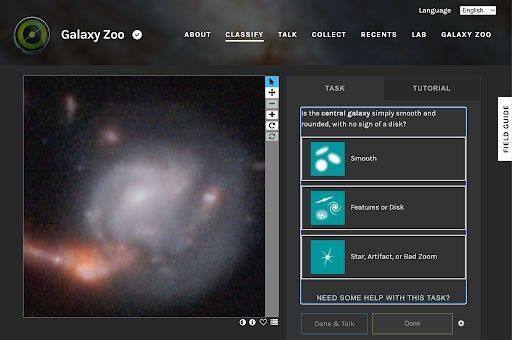
NASA needs your help identifying the shapes of thousands of galaxies in images taken by our James Webb Space Telescope with the Galaxy Zoo project. These classifications will help scientists answer questions about how the shapes of galaxies have changed over time, what caused these changes, and why. Thanks to the light collecting power of Webb, there are now over 500,000 images of galaxies on website of the Galaxy Zoo citizen science project—more images than scientists can classify by themselves.
"This is a great opportunity to see images from the newest space telescope,” said volunteer Christine Macmillan from Aberdeen, Scotland. “Galaxies at the edge of our universe are being seen for the first time, just as they are starting to form. Just sign up and answer simple questions about the shape of the galaxy that you are seeing. Anyone can do it, ages 10 and up!"
As we look at more distant objects in the universe, we see them as they were billions of years ago because light takes time to travel to us. With Webb, we can spot galaxies at greater distances than ever before. We’re seeing what some of the earliest galaxies ever detected look like, for the first time. The shapes of these galaxies tell us about how they were born, how and when they formed stars, and how they interacted with their neighbors. By looking at how more distant galaxies have different shapes than close galaxies, we can work out which processes were more common at different times in the universe’s history.
At Galaxy Zoo, you’ll first examine an image from the Webb telescope. Then you will be asked several questions, such as ‘Is the galaxy round?’, or ‘Are there signs of spiral arms?’. If you're quick, you may even be the first person to see the galaxies you're asked to classify.
"I'm amazed and honored to be one of the first people to actually see these images! What a privilege!" said volunteer Elisabeth Baeten from Leuven, Belgium.
Galaxy Zoo is a citizen science project with a long history of scientific impact. Galaxy Zoo volunteers have been exploring deep space since July 2007, starting with a million galaxies from a telescope in New Mexico called the Sloan Digital Sky Survey and then, moving on to images from space telescopes like NASA's Hubble Space Telescope and ESA (European Space Agency)'s Euclid telescope. The project has revealed spectacular mergers, taught us about how the black holes at the center of galaxies affect their hosts, and provided insight into how features like spiral arms form and grow.
Now, in addition to adding new data from Webb, the science team has incorporated an AI algorithm called ZooBot, which will sift through the images first and label the ‘easier ones’ where there are many examples that already exist in previous images from the Hubble Space Telescope. When ZooBot is not confident on the classification of a galaxy, perhaps due to complex or faint structures, it will show it to users on Galaxy Zoo to get their human classifications, which will then help ZooBot learn more. Working together, humans and AI can accurately classify limitless numbers of galaxies. The Galaxy Zoo science team acknowledges support from the International Space Sciences Institute (ISSI), who provided funding for the team to get together and work on Galaxy Zoo. Join the project now.
Quelle: NASA
----
Update: 4.05.2025
.
James Webb Space Telescope finds coldest exoplanet ever seen, and it orbits a dead star
"That's a big step forward," said Limbach. "It's a rare opportunity to place our own solar system in a broader galactic context."
Limbach and her team plan to conduct a second JWST observation of the WD 1856+534 system this July. By comparing the system's position to background stars a year after the initial observation, researchers hope to spot any additional planets that might be gravitationally bound to the star.
Detecting another planet could explain how WD 1856+534 b migrated to its current close orbit around the white dwarf. Even if no other planets are found, the follow-up data will help astronomers narrow down other possible explanations of how worlds like WD 1856+534b end up orbiting white dwarfs at such a close range, said Limbach.
"Either way, it's a crucial next step in figuring out how these systems evolve."
This research is detailed in a preprint paper posted to the archive arXiv that has yet to be peer reviewed.
Quelle: Space.com

